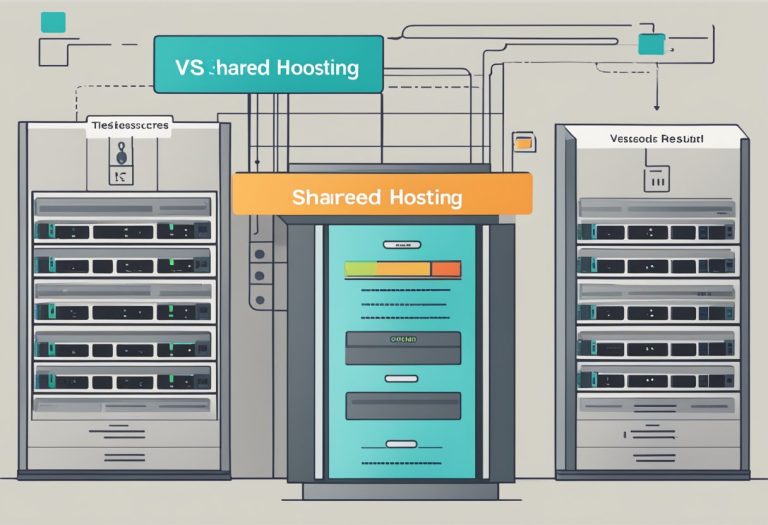When choosing a hosting solution for a website, website owners often face a pivotal decision: shared hosting or VPS hosting. Shared hosting offers a budget-friendly option suitable for beginners, while VPS hosting provides greater control and flexibility for growing businesses. Understanding the fundamental differences between these two options can significantly impact a website’s performance, security, and management.
Shared hosting typically involves multiple users sharing the same server resources, which can limit performance but also reduces costs. Conversely, VPS hosting allows for a virtual private server, offering allocated resources and enhanced customization options. This distinction is critical for those looking to scale their websites or require specific configurations to meet their needs.
With the right knowledge, website owners can make informed choices about their hosting solutions, ensuring they select the best plan for their needs and future growth. This article will explore the key elements of each hosting type, helping readers navigate this important decision.
Key Takeaways
- Shared hosting is ideal for beginners due to its cost-effectiveness.
- VPS hosting offers more resources and control for growing websites.
- Understanding hosting options can guide better choices for website performance.
Understanding Shared Hosting

Shared hosting is a budget-friendly web hosting solution that allows multiple websites to utilize the same server resources. This arrangement offers various benefits and some limitations that website owners should consider before choosing this option.
Basics of Shared Hosting
In shared hosting, a single server is divided among multiple users. Each account shares the server’s resources, such as CPU, RAM, and bandwidth. This setup is particularly appealing to individuals and small businesses with limited technical expertise. Many shared hosting providers offer pre-configured environments, which simplify the process of setting up a website. Users can typically access their accounts via a user-friendly control panel, allowing easy management of files, databases, and email accounts without in-depth technical knowledge.
Advantages of Shared Hosting
One of the main advantages of shared hosting is its affordability. Prices often start at a few dollars per month, making it accessible for startups and personal projects. Additionally, since the server management is handled by the hosting provider, users can focus on content and website design without the need for a technical background.
Another benefit is the availability of customer support. Most shared hosting providers offer 24/7 assistance, which can be crucial for those new to web hosting. Furthermore, many plans come with one-click installations for various content management systems (CMS), greatly simplifying the process of launching a website.
Limitations of Shared Hosting
Despite its advantages, shared hosting does come with limitations. Resource allocation is one notable concern; since multiple sites share the same server, high traffic on one website can slow down others. This might affect user experience and page load times, particularly for sites expecting significant traffic.
Security is another issue, as shared environments can be more vulnerable to attacks. If one site on the server is compromised, it may pose a risk to others. Additionally, users have limited control over server configurations, which can be a setback for those needing specific software or environments for advanced applications.
Understanding VPS Hosting

VPS hosting offers a distinctive solution for those seeking more control and resources than shared hosting provides. It combines dedicated server benefits with the affordability of shared options. This section explores the foundational aspects, advantages, and limitations of VPS hosting.
Basics of VPS Hosting
VPS stands for Virtual Private Server, which creates a virtualized server environment within a physical server. Each VPS operates independently, allowing users to install custom software and configure their environment. Resources like CPU, RAM, and storage are allocated specifically, ensuring performance is less affected by other users. VPS hosting is ideal for websites that experience moderate traffic or require specific configurations that shared hosting cannot support.
Advantages of VPS Hosting
One major advantage of VPS hosting is enhanced performance. Since users have dedicated resources, websites load faster, providing a better experience for visitors. Scalability is another key benefit. Users can easily upgrade their resources as their needs grow, allowing for flexibility without significant downtime.
Security is improved as well, with isolated environments reducing the risk of cross-contamination from other users. Additionally, VPS hosting typically grants users root access, enabling them to modify the server settings and install applications. This level of control is typically unavailable in shared hosting, where configurations are preset.
Limitations of VPS Hosting
While VPS hosting has numerous benefits, it also comes with limitations. Cost is a significant factor; VPS plans are generally more expensive than shared hosting options. This can be a barrier for startups or small businesses with limited budgets.
Complexity is another consideration. Users may need technical knowledge to manage their VPS effectively, particularly when it comes to server administration. This can lead to additional costs if hiring professionals to manage the server is necessary.
Resource allocation, while dedicated, can still be limited compared to dedicated hosting. In high-traffic situations, users may encounter performance lags if their chosen plan does not adequately meet demands.
Key Differences Between Shared and VPS Hosting

When considering shared hosting versus VPS hosting, several critical aspects come into play. These include resource allocation, performance, security, scalability, and price. Each factor differentiates the two hosting types and affects how websites operate in those environments.
Resource Allocation
In shared hosting, multiple websites reside on the same server and share its resources. This means CPU time, memory, and bandwidth are divided among various users. Consequently, if one site experiences high traffic, it may negatively impact the performance of others.
In contrast, VPS hosting offers dedicated resources to each client. Users have a specific amount of CPU power, RAM, and disk space allocated to them. This isolation means that performance is more predictable and not dependent on neighboring websites, leading to more stable operation for individual sites.
Performance
Performance is a significant difference between shared and VPS hosting. Shared hosting can encounter slow load times, especially during peak traffic when available resources are strained. This can lead to a subpar user experience.
Conversely, VPS hosting typically provides better performance due to its dedicated resources. Websites hosted on VPS can handle increased traffic more efficiently. With guaranteed CPU and RAM, load times are improved, and sites can function seamlessly, even under heavier loads.
Security
Security measures vary considerably between the two options. Shared hosting environments are inherently less secure because multiple users operate on the same server. A security breach on one site can expose vulnerabilities in the rest, putting all users at risk.
VPS hosting enhances security by providing a more isolated environment. Each VPS operates independently, making it harder for breaches to affect other users. Additionally, VPS often allows for custom security configurations, enabling users to implement specific measures according to their needs.
Scalability
Scalability presents another essential distinction. Shared hosting is relatively limited when it comes to upgrading resources. Users must usually switch to a more robust plan, which can require downtime and technical adjustments.
VPS hosting offers better scalability. Users can typically upgrade their resources more easily, allowing them to adapt to increasing traffic and demand without significant disruption. This flexibility makes VPS a more suitable option for growing businesses or websites anticipating future growth.
Price Comparison
Price remains a crucial consideration when comparing shared and VPS hosting. Shared hosting is usually less expensive, making it appealing for smaller websites or beginners. Monthly fees often range from a few dollars to around $10.
On the other hand, VPS hosting comes at a higher price point due to the superior features and resources offered. Costs generally start around $20 and can go significantly higher based on allocated resources. While VPS may require a larger initial investment, it provides greater long-term value for websites requiring reliability and flexibility.
Choosing the Right Hosting for Your Website

Choosing the appropriate hosting option requires careful consideration of various factors. Each hosting type, from shared to VPS, has distinct benefits and drawbacks that can significantly impact a website’s performance and management.
Assessing Your Site’s Needs
The first step in selecting a hosting type involves evaluating the specific requirements of a website.
- Traffic Levels: For websites expecting high traffic, VPS hosting may be more beneficial. It offers dedicated resources compared to shared hosting, where resources are distributed among multiple users.
- Resource Requirements: Analyze whether the website requires high CPU, memory, or storage. Resource-intensive applications and websites necessitate the reliability of VPS hosting.
- Technical Expertise: If the site owner has technical knowledge, they may prefer the customization VPS hosting provides. Conversely, shared hosting is ideal for beginners due to its user-friendly interfaces.
Impact on Search Engine Optimization
Hosting can profoundly affect a website’s search engine ranking.
- Loading Speed: Fast loading times are critical for SEO. VPS hosting generally provides better speed as it allocates dedicated resources that enhance performance.
- Uptime Reliability: Downtime can lead to lost traffic and lower search rankings. VPS often guarantees higher uptime percentages compared to shared hosting.
- SSL Certificates: For SEO, SSL is vital. Many VPS plans offer integrated SSL certification options, enhancing security and boosting rankings.
Considerations for E-commerce Sites
E-commerce websites must prioritize security and performance for optimal operation.
- Payment Processing Security: VPS hosting provides enhanced security features, essential for protecting sensitive customer information during transactions.
- Scalability: As an e-commerce business grows, VPS allows for scalable resources to accommodate increased traffic and inventory management without compromising performance.
- Integration Capabilities: Seamless integration with various e-commerce platforms is crucial. VPS environments often offer better support for running complex applications compared to shared hosting, which can be limiting.
Migration Possibilities
When considering a move from one hosting type to another, flexibility is critical.
- Ease of Migration: Switching from shared to VPS generally involves more complex migration processes due to differing server environments.
- Downtime Expectations: Understanding potential downtime during migration is essential. VPS migrations may require predefined maintenance windows to minimize user impact.
- Support Availability: Engaging with hosting providers that offer migration assistance simplifies transitions. A provider’s support can significantly mitigate complications during the switch, ensuring a smoother experience.
Setting Up Hosting for Your Website

Choosing the right hosting setup is critical for launching a website successfully. Whether opting for shared hosting or VPS hosting, each has specific steps and considerations.
Shared Hosting Setup
Setting up shared hosting is typically a straightforward process. Users should begin by selecting a reputable shared hosting provider. Many providers offer beginner-friendly interfaces and services that include one-click installations for applications like WordPress.
- Sign Up: Choose a plan that fits the needs, often based on storage and bandwidth.
- Domain Registration: Users must either register a new domain or point an existing one to the hosting server.
- Configuration: Upon activation, users can access a control panel, such as cPanel, to manage files and install applications.
- Upload Content: Users can use the file manager or FTP to upload website files. Many hosts provide tutorials to assist beginners.
Support services are generally available to assist with any issues during setup.
VPS Hosting Setup
Setting up a VPS hosting environment involves more technical steps compared to shared hosting. This option suits those who desire greater control and flexibility.
- Select a Plan: Choose a VPS plan based on required resources like CPU, RAM, and disk space.
- Operating System: Decide between a Linux or Windows OS as it will affect software compatibility and management.
- Configuration: Users need to access the VPS via SSH or a control panel, such as WHM/cPanel. This step includes setting up firewalls and security protocols.
- Deploy Applications: Users should install necessary software stacks (e.g., LAMP or MEAN) and configure their applications accordingly.
VPS setups often require more technical knowledge, but they offer significantly more control over server management.
Managing Your Hosting Solution
Managing a hosting solution requires understanding the differences between shared hosting and VPS options.
Shared Hosting Management:
- Simplicity: Shared hosting is generally easier to manage. The hosting provider handles most technical aspects.
- Control Panel: Users typically access a user-friendly control panel to manage files, emails, and domains.
- Limited Customization: There are restrictions on server configurations and software installations due to shared resources.
VPS Hosting Management:
- Increased Control: VPS offers root access, allowing users to customize server settings and install custom software.
- Resource Allocation: Resources are dedicated, which helps with consistent performance and stability.
- Technical Knowledge Required: Management may require more technical expertise compared to shared hosting.
Key Considerations:
- Support Options: Check if the hosting provider offers 24/7 support or just basic assistance.
- Backup Solutions: Ensure regular backups are available to prevent data loss.
- Monitoring: VPS users often need to monitor server performance and security more closely than shared hosting users.
Choosing the right management approach depends on individual needs, technical skills, and the level of control desired.
Best Practices for Hosting Maintenance
Regular maintenance is essential for ensuring a smooth operation of both shared and VPS hosting environments. Here are some best practices to follow:
-
Backup Data Regularly
Regularly backing up website data helps prevent data loss. It is advisable to schedule automatic backups. This can be done weekly or bi-weekly, depending on the frequency of content updates.
-
Monitor Performance
Keeping track of website performance metrics like load times and uptime is crucial. Tools such as Google Analytics and uptime monitors can help identify bottlenecks.
-
Update Software and Plugins
Outdated software can create security vulnerabilities. Regularly updating the server operating system, CMS, and plugins is necessary to maintain security and performance.
-
Optimize Databases
Routine optimization of databases can improve loading times. Using tools like phpMyAdmin allows for easy cleanup and optimization of database tables.
-
Utilize Caching
Implementing caching solutions can speed up website performance significantly. Caching reduces the need for repeated data retrieval, improving user experience.
-
Security Measures
Implement firewalls, SSL certificates, and security plugins to protect against threats. Regularly scan for malware and vulnerabilities to maintain a secure hosting environment.
By following these practices, individuals can ensure their hosting environment remains effective and reliable.



